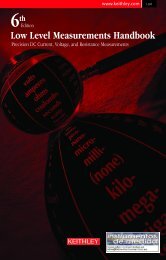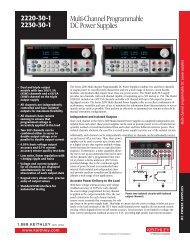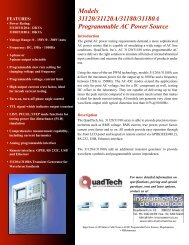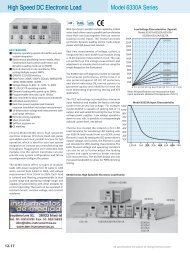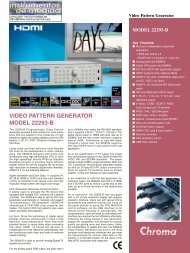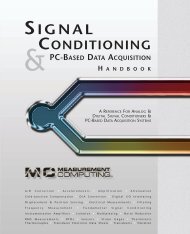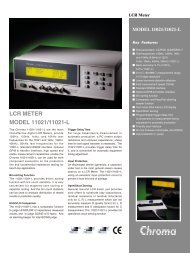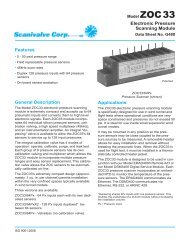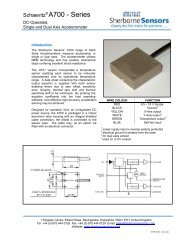You also want an ePaper? Increase the reach of your titles
YUMPU automatically turns print PDFs into web optimized ePapers that Google loves.
A6-ANFSoftwa<strong>re</strong> designThe input to the softwa<strong>re</strong> is the sampled I and Q signals from thephase detectors. These a<strong>re</strong> sampled at a 1kHz rate. As the finalbandwidth of the PLL will be less than 1Hz, this oversampling enablesp<strong>re</strong>filtering to be used which extends the <strong>re</strong>solution and <strong>re</strong>ducesnoise in the 10bit AtoD convertor internal to the microcontroller.Single pole digital filters a<strong>re</strong> used on both the I and Q channels. Thesea<strong>re</strong> implemented as exponential filters which have a 3dB band widthwhich is a function of the “order” of the filter. Filter orders between0 ( no filter) and 15 a<strong>re</strong> provided. This gives bandwidths between114Hz for order 1, and 4.8mHz for order 15. The filter order is variedas the user selected PLL bandwidth is varied.After p<strong>re</strong>filtering, the I and Q channels, now at 16 bit <strong>re</strong>solution, a<strong>re</strong>subsampled at a rate between 15.625 s/s, and 1.953 s/s dependingon the user bandwidth and lock state of the PLL. The “Q” sampleis now divided by the ”I” sample ( after checking that I>Q) to givea binary fraction. This is used to look up the phase value in a TAN-1look up table. The look up table is used to synthesise two types ofphase detector:a) A phase detector with 16 bit <strong>re</strong>solution between Pi/2 and -Pi/2.b) A phase/ f<strong>re</strong>quency detector with 16 bit <strong>re</strong>solution between 2Piand -2Pi. This phase detector is equivalent to the well knowndigital phase/f<strong>re</strong>quency detector. This rolls over between 2Pi and0 for positive cycle slips, and between -2Pi and 0 for negativecycle slips, and will always provide <strong>re</strong>liable lock if the<strong>re</strong> is a initialf<strong>re</strong>quency error.The output of the selected phase detector now has digital gainapplied, selectable between 1/256 and 128. After digital gain, thephase value is added into the integrator, which is 32 bits wide.In order to make the loop stable, by providing a phase lead, the phasevalue has proportional term gain applied, also selectable between1/256 and 128. This value is added to the upper 3 bytes of theintegrator to give the tuning voltage (24 bits)The tuning voltage is divided between the coarse and fine tuneDACs as follows: When normalisation is <strong>perf</strong>ormed, the fine tuneDAC most significant 8 bits a<strong>re</strong> set to mid point ( 80h). The leastsignificant 8 bits of the fine tune DAC a<strong>re</strong> set to the least significant8 bits of the tuning word. The coarse tune DAC is then set to providethe final tuning voltage. During all subsequent tuning, only the finetune DAC is used over its 16 bit range. If the range is exceeded, thenormalisation procedu<strong>re</strong> is <strong>re</strong>peated. A state machine provides controlof locking. After <strong>re</strong>set the last value of the integrator, which has beensto<strong>re</strong>d in EEPROM on a <strong>re</strong>gular basis, is <strong>re</strong>sto<strong>re</strong>d. This will <strong>re</strong>tune thecontrolled oscillator to very nearly the cor<strong>re</strong>ct f<strong>re</strong>quency. The loop isthen opened and the softwa<strong>re</strong> waits for the following all to occur(state 0):a) Rubidium <strong>re</strong>fe<strong>re</strong>nce warm up input to go high.b) OCXO supply cur<strong>re</strong>nt to drop below a th<strong>re</strong>shold showing theOCXO has warmed upc) A measu<strong>re</strong> |I|+|Q| which is an approximate measu<strong>re</strong> of the signallevel at the phase detector to rise above a th<strong>re</strong>shold.When these conditions a<strong>re</strong> fulfilled, the softwa<strong>re</strong> attempts to lock theloop (state 1) by selecting the phase f<strong>re</strong>quency detector, maximumbandwidth, and maximum subsample rate. It then closes the loopand waits for another measu<strong>re</strong>, which is |phase<strong>re</strong>sult|, to drop belowa th<strong>re</strong>shold. The measu<strong>re</strong> |phase<strong>re</strong>sult| is the modulus of each phasecalculation filte<strong>re</strong>d in an 8th order exponential filter, the bandwidth ofwhich, for the 15.625 s/s subsample rate, equals 9.7mHz.Once the lock th<strong>re</strong>shold for |phase<strong>re</strong>sult| is <strong>re</strong>ached, the lock state (state 2) is ente<strong>re</strong>d. The bandwidth is switched to the users selectedbandwidth, which has been maintained in EEPROM, and the phasedetector is switched over to the narrow band phase detector (Pi/2to -Pi/2). All the time during normal operation, |phase<strong>re</strong>sult| is beingcompa<strong>re</strong>d to a lower th<strong>re</strong>shold than the lock th<strong>re</strong>shold. If it exceedsthis th<strong>re</strong>shold, state 3 is ente<strong>re</strong>d which provides a brief flash of thelock LED to warn the user that the selected bandwidth may be toonarrow for the PLL to track the drift of the controlled oscillator fastenough. This low th<strong>re</strong>shold is cur<strong>re</strong>ntly set at 480ps maximum phaseerror.In ext<strong>re</strong>me cases the lock th<strong>re</strong>shold (4.8ns phase error) may beexceeded, in which case the softwa<strong>re</strong> assumes lock is lost and <strong>re</strong>entersstate 1. A further <strong>perf</strong>ormance measu<strong>re</strong> is calculated, whichis available over the interface. This is the first diffe<strong>re</strong>nce of the phaseerror, filte<strong>re</strong>d in an 8th order exponential filter. It is cor<strong>re</strong>cted forsubsample rate, and has a constant sensitivity of 5.8x10-15 per bit.(at 10MHz phase detector f<strong>re</strong>quency)This <strong>perf</strong>ormance measu<strong>re</strong> gives the mean fractional f<strong>re</strong>quencydiffe<strong>re</strong>nce between the controlled oscillator and the <strong>re</strong>fe<strong>re</strong>nce, and isuseful for setting up the optimum bandwidth of the PLL.The band width and damping of the PLL is controlled by 4parameters, integrator digital gain, proportional digital gain, p<strong>re</strong>filterorder, and subsample rate. These a<strong>re</strong> p<strong>re</strong>set for 8 values of userselected bandwidth, and can only be changed by modifying thesoftwa<strong>re</strong>. It is possible to temporarily adjust the four individualparameters as part of a test procedu<strong>re</strong> carried out over the RS232interface. The selection of the 4 parameters has been optimisedusing a mathematical model of the PLL modelled as a MATHCADsp<strong>re</strong>adsheet. This could be made available to customers who wishedto <strong>re</strong>adjust the PLL parameters.26Tel +44 (0)1803 862062Fax +44 (0)1803 867962Email sales@quartzlock.comwww.quartzlock.com



